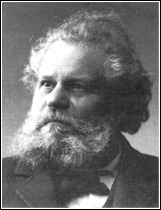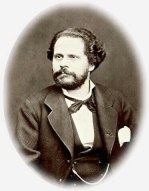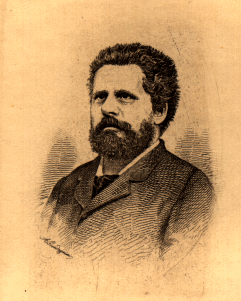
Giosue Carducci: 19th Century Poet, Statesman and Satanist
R. Merciless

In 1906 the Nobel Prize for literature was awarded to Giosue Carducci of Italy for extraordinary lifelong accomplishment in the field of poetry. He was a Satanist.
By the time he won the Nobel, Carducci had firmly established himself as one of the world’s most well-known and influential literary figures with a large body of distinguished work and a long career of artistic achievement, political activism and religious agitation. He had published several volumes of poetry attracting worldwide critical acclaim. In addition, his prose writings including literary criticism, biographies, speeches and essays filled some 20 volumes. [1] He had also been elected a Senator of Italy and voted a very substantial life-long pension. The Nobel prize was merely the capstone of a long, brilliant and highly successful life. [2]
Carducci’s credentials as a Satanist include not only his worldly successes and overt opposition to Christianity but his writing of the highly controversial poem, Inno a Satana or “Hymn to Satan.” In writing, publicly reciting and twice publishing this astounding poem, he stepped firmly beyond his paganism and even his anti-clericalism into the realm of modern Satanism by embracing the mythic character of Satan as an exemplary role model and heroic archetypal symbol. Indeed, it is this taking of Satan as an exemplar symbol that is the defining characteristic of the Modern Satanist. [3]

Of course, living as he did in 19th century Italy, Carducci probably would not have referred to himself as a “Satanist.” The linking of that term to the Satanic character would have to wait almost exactly 100 more years when Anton Szandor LaVey, founder of The Church of Satan, defined it for the modern world in The Satanic Bible in 1969. [4] Nonetheless, Carducci’s explicit and life-long adoption of Satan as archetypically symbolic of his personal philosophy which he called “radical rationalism,” unequivocally places the Nobel laureate firmly within the Satanic tradition, even if less daring biographers have preferred the term “pagan” to describe him.
Carducci felt great affinity for the classical world and wrote several internationally acclaimed homages to ancient Roman gods and the long lost, Christian-obliterated happy pagan lifestyle of old. But unlike Baudelair, Leopardi, Levi, Rimbaud, Huysmans and other 19th century literary figures who penned somewhat Satanic works, Carducci did not die on his knees whimpering and begging forgiveness from a previously scorned Christian god.[5]Instead, he died an unabashed enemy of the Pope and ended his days as defiantly anti-clerical as he ever was.
Carducci was born near Verana, Italy in 1835. From an early age, guided by his politically active physician father, he learned Latin and studied the Iliad and classical works of Homer. He also energetically read the works of the famous Italian poet, Giacomo Leopardi (1798 - 1837) and was perhaps somewhat inspired towards Inno a Satana by reading the despondent Leopardi’s unfinished Ad Ahrimane (“To Ahriman,”) an at times depressing prayer addressed to the Prince of Darkness and acknowledging His rule of the Earth. [6]

By 1860, at age 25, he had been appointed to the chair in Italian Literature at Bologna University where he would spend a long, brilliant career of over 40 years. He was also actively involved in the political upheavals reshaping Italy at the time.
It was a time of revolution in Italy as Republicans, inspired and assisted by revolutionary France, struggled to throw off the old tyrannical Hapsburg order and unite and democratize Italy’s many separate feudal states and kingdoms. By the mid-1860s, after years of civil war and political struggle most of the Italian peninsula had been united under a constitutional republican monarchy. However, one of the last vestiges of tyrannical domination on the Italian peninsula was the continued direct political control of Rome and surrounding regions by the Pope. With the military backing of Hapsburg Austria, the Pope held direct secular political power over the Italian provinces known as the Papal States. Naturally, the anti-clerical freethinkers among the Republicans found tyrannical rule by the papacy to be as odious as, or even worse than, that by unelected, hereditary nobles. Both impeded human progress by locking power in the hands of those who were long on hereditary or ecclesiastical connections and short on any actual demonstrated merit or ability.
Throughout Italy, 19th century Masonic lodges were centers of organizing revolutionary activities ranging from anti-royalist propaganda to underground guerrilla attacks. Carducci was, of course, a member as were nearly all the other significant leaders of the Italian revolutionary movement. Other prominent masons of the time included influential political philosopher Giuseppe Mazinni, head of the successful Young Italy movement, and Giuseppe Garibaldi, the internationally famous Italian revolutionary war hero.
In contrast to the overtly theistic and even Christian flavor to be found among German and Anglo-American Freemasons at the time, French and Italian masonry both adopted a much more pan-religious, nearly overtly atheist tone. Like Masons everywhere, they too used the term “Grand Architect of the Universe” to refer to the “creator.” For many of the more sharp-witted Italian and French Masons, however, it had a very different meaning. Applauding its own expansive view of the Mason’s “Grand Architect”, the official newsletter of the Italian lodge noted,
“The formula of the Grand Architect, which is reproached to Masonry as ambiguous and absurd, is the most large-minded and righteous affirmation of the immense principle of existence and may represent as well the (revolutionary) God of Mazzini as the Satan of Giosue Carducci (in his celebrated Hymn to Satan); God, as the fountain of love, not of hatred; Satan, as the genius of the good, not of the bad.” [7]
This Masonic newsletter reference to Carducci in the same breath as Mazzini, one of the republic’s most effective and inspiring revolutionary thinkers and leaders, clearly demonstrates Carducci’s great prominence and influence at the time. Moreover, the sort of religious outlook quoted above made all of Italian masonry an explicit enemy of the Vatican. On March 18, 1902, Pope Leo XIII issued “Annum ingressi,” a pronouncement against Italian Freemasonry. Of the above quotation, The Catholic Encyclopedia of 1910 disapprovingly sniffed, “In both interpretations it is in reality the principle of Revolution that is adored by Italian Masonry.”
The deep anti-church sentiment of French masons—most likely shared in full by their Italian brothers—is amply reflected in the following quote from a 20 September, 1902 speech by Senator Delpech, president of the Grand Orient de France:
“The triumph of the Galilean has lasted twenty centuries. But now he dies in his turn. The mysterious voice, announcing (to Julian the Apostate) the death of Pan, today announces the death of the impostor God who promised an era of justice and peace to those who believe in him. The illusion has lasted a long time. The mendacious God is now disappearing in his turn; he passes away to join in the dust of ages the divinities of India, Egypt, Greece, and Rome, who saw so many creatures prostrate before their altars. Bro. Masons, we rejoice to state that we are not without our share in this overthrow of the false prophets. The Romish Church, founded on the Galilean myth, began to decay rapidly from the very day on which the Masonic Association was established.”[8]
Carducci, the firebrand masonic freethinker and revolutionary, wrote Inno a Satana in September 1863, at the age of 28 and three years into his teaching chair at the University of Bologna. It was composed as a brindisi or toast which he recited at a dinner party among friends. [9] Appropriately for reciting with a raised glass of chianti, the poet titled it “A Satana” or “To Satan.” It was then published in 1865 under the title Inno a Satana or “Hymn to Satan” but should probably have more accurately carried the title of “A Toast to Satan.” The tone, rhyme, meter and content all bear this out clearly and well-reflect the origination of the work. It is not difficult to imagine a table full of Carducci’s freethinking revolutionary pals hoisting their glasses at the conclusion of the recitation, shouting “Here, here,” and quaffing a glass of Italy’s finest produce. In vino veritas, indeed!
Modern literary scholars have recognized Inno a Satana as an in-your-face manifesto of Carducci’s most deeply felt convictions and cherished beliefs, which he occasionally modified but never abandoned over the course of his long life. For Carducci, like for LaVey, Satan symbolically represents all of those wonderful things which the hierarchy of orthodox Christianity opposes and attempts to suppress: beauty in nature and art, sensual pleasures, confidence in man’s ability to transform the physical world, freedom of thought and expression, unprejudiced intellectual inquiry, economic and social progress.
It is unfortunate that an English-reading person of the 21st century is not able fully to grasp the emotional power the poem invoked in 19th century Italy with its clever rhyming language and allusions to well-known recent and historical events and figures. Still, it can serve as an inspiration to others. Indeed, a glimmer of the impact can be discerned by seeing it (and even trying to read it aloud) in its original Italian. All readers should try this.
[To open a window showing Inno a Satana in Italian and English, click here.]
Readers will note that Carducci’s poem includes 50 stanzas of 4 lines each where the second and fourth are rhymed. This meter seems to resonate something like a a train’s locomotive steaming along under full power and this is a metaphor which the poet brings around the bend into full view at the close of the poem.
It was published a second time in 1869 in Bologna’s radical newspaper, Il Popolo, as a provocation timed to coincide with the 20th Vatican Ecumenical Council, a time when revolutionary fervor directed against the papacy was running high as republicans were pressing both politically and militarily for an end of the Vatican’s domination over the so-called papal states under the military support of the hated Austrian Hapsburgs.
The second publication was meant to be a provocation and provocative it was. Reaction to the reappearance of the controversial poem was quite strong. Even some of Carducci’s fellow republicans publicly distanced themselves from embracing Satan along with the poet even if they were opposed to the Pope. Moderate newspapers excoriated Carducci for potentially harming the cause with such blasphemous and inflammatory writings.
But, in fact, the republican cause was triumphant. In 1870, Hapsburg Austrian military support for the Pope collapsed and republican troops marched into Rome, ending by force the papacy’s secular political control of the region. It is quite likely that, as they took the city, at least some of those troops had Inno a Satana fresh in their minds.
But, as moderate republicans had feared, the Vatican seized upon the poem as a propaganda item. As Carducci introduced Satan as a worthy and honorable symbol of the republican opposition to the tyrannical earthly power of the papacy, the Vatican’s propaganda to its faithful sheep painted the revolutionaries as accursed minions of the literal Devil. The 1910Catholic Encyclopedia proclaimed Masonic Lodges to be
“the advanced outposts and standard-bearers of the whole immense anti-Catholic and anti-papal army in the world-wide spiritual warfare of our age. In this sense also the pope, like the Masonic poet Carducci in his Hymn to Satan, considers Satan as the supreme spiritual chief of this hostile army.” [10]
Clearly the Catholic Church stewed with such great frustration and hatred for the masons’ anti-clerical activity, that it’s disdain for Carducci in particular was never far from mind as indicated in the above passage. Had he lived to read it, Carducci would have no doubt been pleased to see his name thus immortalized in the Catholic Encyclopedia as a leading enemy of the church.
While Inno a Satana was extremely effective as a political device it was not considered by scholars and critics—or even by Carducci—to be great art. In the middle part of a major Oxford University lecture on Carducci’s work in 1926, scholar John Baily, for example, offered the following analysis of Inno a Satana:
“It is at the bottom [Carducci’s] faith in a sound mind and healthy body, [his] scorn of weaklings and palterers, which is the inspiration of the famous, or notorious Hymn to Satan. I cannot, of course, discuss it here from the point of view of religion. It gave and no doubt was meant to give, great offence to Catholics and indeed to all Christians—and still does. We must admit that he was always definitely a pagan: and often, especially in the first half of his life, not merely a pagan but an anti-Christian. This attitude is seen at its height in the Hymn to Satan though the title is, as we shall see, a misnomer. But to judge it or him fairly we must remember the time and place in which he wrote: an Italy which had long been ruled by priests who allied themselves with foreigners and tyrants, in which the Pope who had deserted the national cause still held Rome; in which one Pope had declared the steam engine to be an invention of the Devil and another was now replying to the spirit of the nineteenth century by getting himself declared Infallible. The Ode was written in one day in 1863, published in 1865, and again on the day of the opening of the Vatican Council. It is enough if it stood alone to disprove the notion of Carducci as mere academic pedant. It sputters with fiery life from the first word to the last. But the Satan whom it proclaims and glorifies is not the spirit of evil; there is no less immoral poet than Carducci. His Satan is reason and nature, the body and the mind, all that revolts against the asceticism, sacerdotalism and obscurantism which have so often claimed to represent the Christian religion. The Hymn is as full of imagination as it is of spontaneity, sincerity, and strength. What it is not full of, either in thought or in language, is that grave music of the mind and of the word without which poetry cannot be entirely itself...Carducci’s [Hymn to Satan] reads as little more than a piece of polemical journalism.” [11]
Thereafter, Bailey went on to speak of what “is great and permanent” in the work of Carducci and to enumerate the many later poems and prose which did, indeed, in his opinion rise to the highest levels of the literary art and which were, of course, the basis of his winning the Nobel Prize. At the close of his lecture, Bailey concluded:
“The smith does not always succeed nor does the poet, each is clumsy sometimes and each sometimes finds his metal too hard to shape. What I have wished to say today is that Carducci succeeded often, and that when he succeeded it was with such materials, so finely worked, that his place among the poets is assured and immortal.”
So, despite the revolutionary impact of Inno a Satana, Carducci’s greatest poetic achievements still lay ahead. Carducci was a revolutionary on multiple fronts both political and artistic. Like his politics, Carducci’s more advanced poetry became revolutionary as well. He was not afraid to undertake bold, daring adventures in his works. The Rime Nuove(“New Rhymes”) and the Odi Barbare (“Barbaric Odes”) which appeared in the 1880s contain the best of Carducci’s poetry.
Odi Barbare in particular included brilliant, ground-breakng innovations. Carducci reintrocued old classical Latin poetry styles and meters into contemporary Italian-language works. This adaptation of ancient technique to new Italian recalled the pace and flavor of Homer and Virgil and was Carducci’s way of honoring both classicism and paganism. It was also an attack upon two things he abhorred: the romanticism in contemporary poetry and the Christianity in contemporary society. Indeed, all of Carducci’s work extolled Italian hope and Roman glory and was an assertion of classic reason as opposed to romantic mysticism and Roman Catholic piety.
He also wrote scathing reviews of what he considered trite sentimentalism in the gushing, unoriginal romantic poetry being churned out and lauded by his contemporaries.
These were all gutsy moves. To undertake such radical innovation in his own work and to so harshly criticize the popular Romantics, Carducci certainly showed he was willing to risk attracting condemnation that could hamper his popularity and his career. But, just as he had helped republican efforts to liberate Italian political life from royalist Hapsburg and Papal domination, Carducci also lead the liberation of Italian poetry from sentimental romanticism while at the same time offering it the innovation of his re-introduction of the meters of the classics. This was the cutting-edge artistry that brought him the Nobel.
When Carducci was selected to receive Nobel Prize in recognition of his worldwide acclaim, he was an old man and, indeed, was too ill to travel to Stockholm to accept the award in person. Had he been present, the Nobel committee might not have been so presumptuous as to try to make apologies for the great poet’s “Satanism” or to attempt to separate him from Inno a Satana.
It is clear that even the relatively progressive intellectuals of the Nobel committee were uneasy with publicly embracing a pagan and Satanist like Carducci before a global audience. Their efforts to downplay these aspects of the man are evident in the presentation speech properly noting that his poetic brilliance transcended such things and (improperly) trying to show that he had disavowed/retracted Inno a Satana.
While the whole of the Nobel presentation speech included the expected long laudatory recounting of the honored poet’s life and accomplishments, it also included this tidbit of back-pedaling.
There is a good deal of justice in many of the attacks on Carducci’s anti-Christianity. Although one cannot perfectly approve of the way in which he has tried to defend himself in Confessioni e Battaglie (“Confessions and Battles”) and in other writings, knowledge of the attendant circumstances helps to explain, if not to justify, Carducci’s attitudes.
Carducci’s paganism is understandable to a Protestant, at least. As an ardent patriot who saw the Catholic Church as in many ways a misguided and corrupt force opposed to the freedom of his adored Italy, Carducci was quite likely to confuse Catholicism with Christianity, extending to Christianity the severe judgments with which he sometimes attacked the Church.
And as to the impetuous Inno a Satana, it would be a great wrong to Carducci to identify him, for example, with Baudelaire and to accuse Carducci of poisonous and unhealthy “Satanism.” In fact, Carducci’s Satan has an ill-chosen name. The poet clearly means to imply a Lucifer in the literal sense of the word—the carrier of light, the herald of free thought and culture, and the enemy of that ascetic discipline which rejects or disparages natural rights. Yet it seems strange to hear Savanarola praised in a poem in which asceticism is condemned. The whole of the hymn abounds with such contradictions. Carducci himself in recent times has rejected the entire poem and has called it a “vulgar sing-song.” Thus, there is no reason to dwell any longer on a poem which the poet himself has disavowed. [12]
Their little fig leaf probably fooled no one for it was obvious that the master poet Carducci looked back to the dinner-table political toast of the early days of his art with a condemning eye only in assessing the poem’s lack of artistic sophistication. Calling the poem “vulgar sing-song” was merely a repudiation of its youthful, immature poetic style. In his professional work, having introduced immense contributions to the field of poetry, he had long since moved beyond the silly, elementary structure of the provocative little rhyme he shared with friends and compatriots over a raised wine glass. But such self-criticism of that early work certainly did not imply any rejection of the substance of the sentiments expressed therein. Those he held to without apology to the very end of his days.

“I know neither truth of God nor peace with the Vatican or any priests. They are the real and unaltering enemies of Italy.” he said in his later years. [13]
At the end of Carducci’s life, Romanticism, Catholicism and (one could argue) political domination remained quite popular with the great mass of Italians, but his daring stabs at all three had unforgettably opened the door for the elite few seeking to liberate themselves politically, artistically and religiously. His lasting contribution to freedom of the mind and spirit is forever immortalized in the roster of the Nobel Prize, the highest literary distinction on Earth; in a beautiful stone monument in Bologna; in the pages of his still-acclaimed works, and in the hearts of all that they still touch. And really, how much more immortality can any successful Satanist hope for than that?
NOTES & REFERENCES
- Carducci, Giosue, Selections from Carducci; Prose and Poetry with introduction, notes and vocabulary by A. Marinoni, (William R. Jenkins Co.; New York) 1913. pp vii - ix [BACK]
- Scalia, Samuel Eugene, Carducci, (S.F. Vanni, Inc., New York) 1937. [BACK]
- LaVey, Anton Szandor, The Satanic Bible, (Avon, New York) 1969. p 25 [BACK]
- Barton, Blanche, The Church of Satan, (Hells Kitchen, New York) 1990. p 60 [BACK]
- Regarding the later day Christianity of Baudelaire see Russell, Jeffrey Burton, Mephistopheles: The Devil in the Modern World, (Cornell University Press; Ithaca, New York) 1986. p 208. Regarding Rimbaud, see Russell p 209. Regarding Levi, see Waite’s preface of Levi, Eliphas, The History of Magic translated by A.E. Waite, (Samuel Weiser, Inc., York Beach, ME) 1913 p. 7. [BACK]
- Zacharias, Gerhard, The Satanic Cult, transl. by Christine Trollope, (George Allen & Unwin, London) 1964. p.125 [BACK]
- Rivista, 1909, p 44 [BACK]
- Compte-redu Grand Orient de France, 1902. p 381 [BACK]
- Carducci, Giosue, Selected Verse/ Giosue Carducci: edited with a translation, introduction and commentary by David H. Higgins, (Aris & Phillips; Warminster, England) 1994. pp34-47, 227-229 [BACK]
- The Catholic Encyclopaedia, “Masonry (Freemasonry)” , (https://www.newadvent.org/cathen/09771a.htm) 1910 [BACK]
- Bailey, John Cann, Carducci - The Taylorian Lecture, (Clarendon Press, Oxford) 1926. [BACK]
- Nobel Lectures, Nobel Prize for Literature 1906 - Presentation Speech, (https://www.nobel.se/literature/laureates/1906/index.html) [BACK]
- Carelle, Naturalismo Itialiano, cited at https://www.infidels.org/library/historical/joseph_mccabe/dictionary.html [BACK]

Portrait

R. Merciless
Priest in the Church of Satan
We Are Legion
A Moment In Time
This slideshow requires JavaScript.
SUPPORT THE
CHURCH OF SATAN!
There are many ways you can support the Church of Satan. Visit our support page to learn how.
navigation-topper


